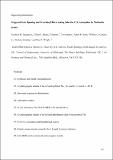Triggered gate opening and breathing effects during selective CO2 adsorption by merlinoite zeolite
Abstract
Zeolites with flexible structures that adapt to coordinate extraframework cations when dehydrated show a rich variety of gas adsorption behavior, and can be tuned to optimize kinetics and selectivity. Merlinoite zeolite (topology type MER) with Si/Al = 3.8 has been prepared in Na, K and Cs forms and its structural response to dehydration measured: the unit cell volumes decrease by 9.8%, 7.7% and 7.1% for Na-, K-, and Cs-MER, respectively. Na-MER adopts Immm symmetry, while K- and Cs-MER display P42/nmc symmetry, the difference attributed to the preferred locations of the smaller and larger cations. Their performance in CO2 adsorption has been measured by single component isotherms and by mixed gas (CO2/CH4/He) breakthrough experiments. The differing behavior of the cation forms can be related to structural changes during CO2 uptake measured by variable-pressure PXRD. All show a "breathing" transition from narrow to wide pore forms. Na- and Cs-MER show non-Type I isotherms and kinetically-limited CO2 adsorption and delivery of pure CH4 in CO2/CH4 separation. However, K-MER shows good uptake of CO2 (3.5 mmol g-1 at 1 bar and 298 K), rapid adsorption and desorption kinetics, and promising CO2/CH4 separation. Furthermore, the narrow-to-wide pore transition occurs rapidly and at very low pCO2, via a "triggered" opening. This has the consequence that whereas no CH4 is adsorbed from a pure stream, addition of low levels of CO2 can result in pore opening and uptake of both CO2 and CH4, although in a continuous stream the CH4 is replaced selectively by CO2. This observed cation size-dependent adsorption behavior derives from a fine energetic balance between different framework configurations in these cation-controlled molecular sieves.
Citation
Georgieva , V M , Bruce , E L , Verbraeken , M , Scott , A , Casteel , W , Brandani , S & Wright , P A 2019 , ' Triggered gate opening and breathing effects during selective CO 2 adsorption by merlinoite zeolite ' , Journal of the American Chemical Society , vol. 141 , no. 32 , pp. 12744-12759 . https://doi.org/10.1021/jacs.9b05539
Publication
Journal of the American Chemical Society
Status
Peer reviewed
ISSN
0002-7863Type
Journal article
Description
The authors thank the EPSRC for funding (‘Cation-controlled gating for selective gas adsorption over adaptable zeolites’: EP/N032942/1, VMG, PAW; EP/N033329/1, MV and SB; an NPIF PhD scholarship for ELB, EP/R512199/1). Professor Tina Düren (Bath University) and Drs. Carole Morrison and Claire Hobday (Edinburgh University) are thanked for their helpful suggestions. Dr. Paul A. Connor, Dr. Yuri Andreev and Dr. Daniel Dawson (St. Andrews University) are thanked for assistance with in situ PXRD measurements (PAC, YA) and NMR (DMD). All data accompanying this publication are directly available at https://doi.org/10.17630/594363b9-966c-4c53-89e1-7610be33eba5.Collections
Items in the St Andrews Research Repository are protected by copyright, with all rights reserved, unless otherwise indicated.

